The overrepresentation of bottlenose dolphins (Tursiops spp.) undermines the real diversity within the Delphinidae family, thus warranting a look at a species like the Pacific white-sided dolphin (Lagenorhynchus obliquidens). This species is endemic to the North Pacific, spanning across Baja California, Southern China, and the Bering Sea. The North Pacific white-sided dolphin has been traditionally classified under the dolphin genus Lagenorhynchus, however, molecular data revealed that most members were not closely related to the type species, the Atlantic white-sided dolphin (L. acutus). While this genus is currently under revision, experts have proposed the genus name Sagmatias for this species and its close relatives, like the dusky dolphin (L. obscurus). North Pacific white-sided dolphins are average-sized among oceanic dolphins: adults range from 1.7-2.5 meters and 90-198kg. These animals are known to be very acrobatic and curious around humans. While overshadowed by other captive cetacean species, the Pacific white-sided dolphins are fairly prominent in captivity, with 100 captive individuals between North America and Japan. Population estimates are data-deficient but individuals are thought to be in excess of 1 million. Historically, several East Asian countries engaged in large-scale hunts of this species until their banning in 1993. In Japan, this species continues to be caught in the Taiji dolphin drives. North Pacific white-sided dolphins feed on small schooling fish, cephalopods, and occasionally shrimp. The main predators of this species are the Bigg’s killer whale, the great white shark, and potentially other large shark species.
 Once again I’m taking another look at a cetacean from CollectA. I prioritize CollectA’s whales not simply because of their quality, but due to their decent coverage of underrepresented species. Such examples that this blog already reviewed include the Ganges river dolphin, minke whale, pilot whale, bowhead whale, and pygmy sperm whale. Today we’re looking at the Pacific white-sided dolphin released back in 2013.
Once again I’m taking another look at a cetacean from CollectA. I prioritize CollectA’s whales not simply because of their quality, but due to their decent coverage of underrepresented species. Such examples that this blog already reviewed include the Ganges river dolphin, minke whale, pilot whale, bowhead whale, and pygmy sperm whale. Today we’re looking at the Pacific white-sided dolphin released back in 2013.
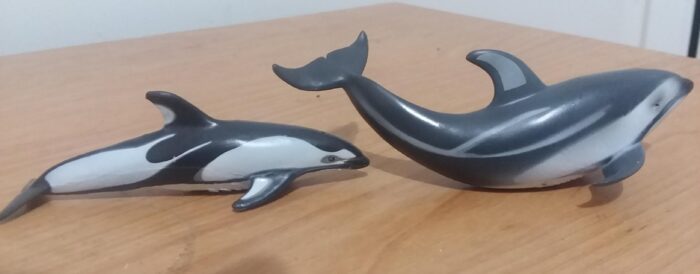
When accounting for the pose, the figure measures approximately 13.5cm in length, placing it in the 1:13-1:19 scale range for a typical adult. Compared to Safari Ltd’s release of this species under the Monterey Bay Aquarium line, Collecta’s figure is notably a bit larger. Nonetheless, this figure can still fit well with 1:20 scale marine life if treated as a larger specimen of this species. However, I prefer how the MBA figure is posed. The upright tail on the CollectA figure echoes my complaints with the pilot whale.

The sculpt follows the precedent set by the previously reviewed cetaceans from CollectA. The proportions, shape of the skull, flukes, pectoral fins, and dorsal fin are all in line with what should be expected of this species. Even when holding the CollectA series to a high standard, there are no anatomical minutiae that stick out to me as explicitly inaccurate.

The only detail of note is the lack of a genital slit, which is present on other cetaceans from this brand. Even then, that’s not even necessarily a knock against this figure, as its absence allows it to be sex-neutral. The CollectA Pacific white-sided dolphin is definitely an upgrade over the MBA figure with regards to the sculpt.
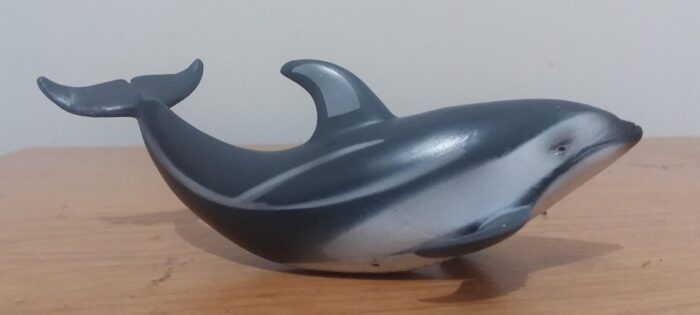
Unfortunately, I have seen some room for criticism regarding the paint scheme for this species’ coloration. Now overall, it’s not bad. And to be lenient, there is a lot of variation between individuals. However, I have seen complaints regarding how ”bland” this figure looks compared to the real animal. In my opinion, I would say the anterior portion of the animal looks great up to the dorsal fin. My biggest complaint regards the dorsal fin, where hard lines divide the two tones rather than a blurred boundary between the darker anterior side and the light posterior edge. Another problem regards the tail.
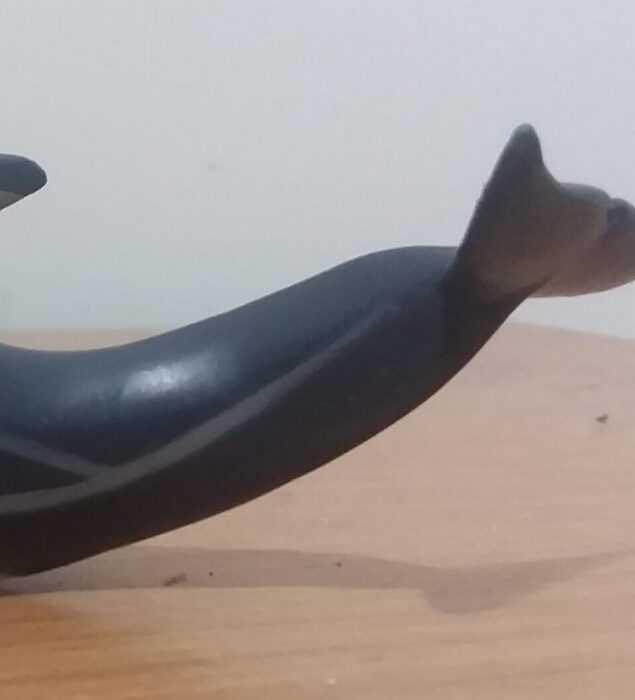
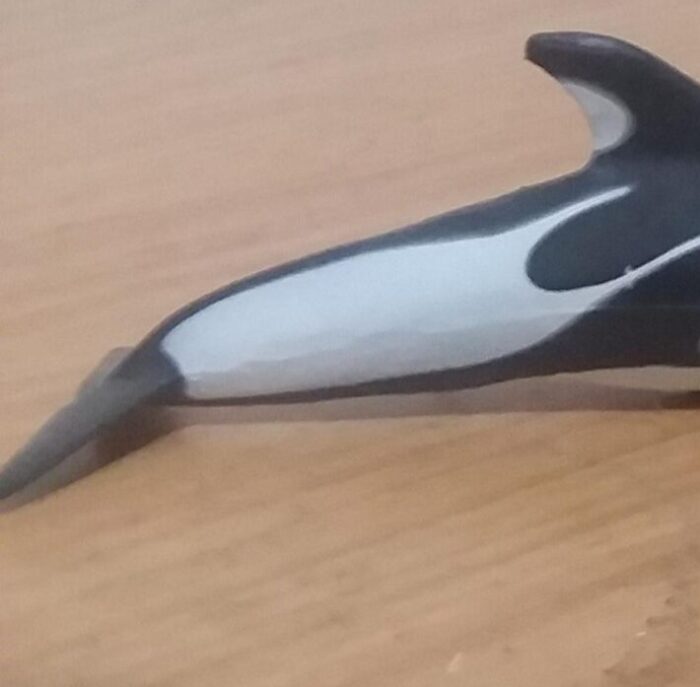
As you can see, the sides of the tail on the CollectA figure only bear a mere white stripe. On the real animal, the lighter tone, be it grey or white, should encompass a greater area, similar to the MBA figure. The diminished contrast along the tail makes the CollectA dolphin less visually striking compared to the MBA figure overall.
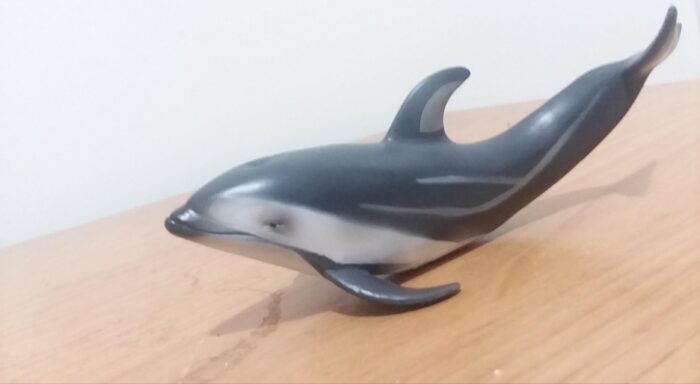
Taken all together, I still consider this release to be another win for CollectA. While the pose and paintjob compromise the figure’s full potential, there are not enough mistakes to limit my recommendation of this figure to others. This is especially in light of the alternative for the species at this scale, the MBA figure, having been retired for a very long time and being extremely rare. The CollectA figure is still in production, I recommend anyone who’s interested in this figure to purchase one while they can.
Disclaimer: links to Ebay and Amazon on the AnimalToyBlog are affiliate links, so we make a small commission if you use them. Thanks for supporting us!




I have this figure in my collection and like it a lot, too!
As many positives as I can say about this figure, I have to put this one into the flop category for CollectA. This species is well represented in figure form, not just by the long-retired MBA figure (which was, IMO, the superior figure for several reasons), but by numerous Japanese figures. This should have been a homerun for CollectA, but the awkward pose, the inaccurate color pattern, and the dull gray color all add up to a swing and a miss. CollectA deserves a do-over on this one.
I’m aware there are other figures from Japanese manufacturers, but as I stated at the end the review, the MBA is the only other one I know of that’s produced at a similar scale. To my understanding, most of the Japanese figures I’ve found were much smaller. While I have issues with the pattern going past the dorsal fin, the dull gray doesn’t bother me. One can valdily criticize it as not aesthetically pleasing, but I don’t consider it inaccurate. The actual species exhibits a wide degree of variation, which includes gray morphs.